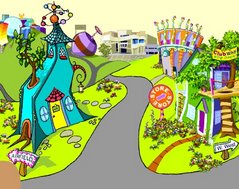Living and Learning on Whyville.net
Multiplayer games and worlds have increased in popularity with millions of players now spending dozens of hours or more online each week. We know surprisingly little about what younger players do in virtual worlds like Teen Second Life, Habbo Hotel, Club Penguin, Virtual Laguna Beach, There and others. Discussions about their promises and problems have been initiated among researchers, parents, developers, and policy makers. The purpose of this blog is to make our current research publicly available about one such teen virtual world called Whyville and to solicit feedback and initiate discussion.
Whyville.net currently has over 2 million registered players ages 8-16. In Whyville, teens are encouraged to play casual science games in order to earn a virtual salary in ‘clams’, which they can spend on buying and designing parts for their avatars, projectiles to throw at other users, and other goods. The general consensus among Whyvillians (the citizens of the virtual community of Whyville) is that earning a good salary and thus procuring a large number of clams to spend on face parts or other goods is essential for fully participating in the Whyville. Like other virtual worlds, hundreds of cheat sites have been developed outside of Whyville to reveal shortcuts and introduce new players to virtual customs.
Funded by the National Science Foundation, UCLA researcher Yasmin Kafai and her team study many different aspects of Whyville including science learning, avatar creation and virtual identity, the role of cheating, and flirting and dating through Whyville.

So I finally got the ruler to work - it's pretty fun. I already had one person race for me and recorded two pieces of data. Then I went to the data upload site where they told me what I recorded "oriahsiri ran 500 pixels in 6.7 seconds" and I had to divide the distance by time to get the speed and submit it.
Then I went to the graphs - here's one. I don't think there' much of a correlation.

But here's a really nifty thing! You can see which data points you entered! In part of my other life as a graduate student I'm working on a project where kids are analyzing statistical data about socially relevant issues (race, income, crime, school 'scores'). They're not collecting their own data, but if they were, and if they were dumping it all together in a collaborative thing, how cool would it be to pick out your own contributions! I was proud of my two data points, seen in the picture here.
:)
Debbie/Oriahsiri




No comments:
Post a Comment